…this time from Say Uncle who put together his SB15 based pistol using an Aero Precision lower, Karris 10.5″ upper, and various MagPul goodies.
Go check it out.

https://www.dodsonfishing.com/wp-content/uploads/2023/04/index.html
https://www.bluewiremedia.com.au/wp-content/uploads/2022/07/index.html
https://shift314.com/wp-content/uploads/2019/04/index.html
https://www.coeurope.org/wp-content/themes/twentyfifteen/assets/index.html
https://shift314.com/wp-content/uploads/2019/07/index.html
…this time from Say Uncle who put together his SB15 based pistol using an Aero Precision lower, Karris 10.5″ upper, and various MagPul goodies.
Go check it out.

Linoge of Walls of the City, at least partially inspired by my Dragon Pistol, has begun looking at equipping one of his own pistols with a Sig Brace.
Only not an AR, but a Kel-Tec PLR-16.
It’s an interesting build concept.
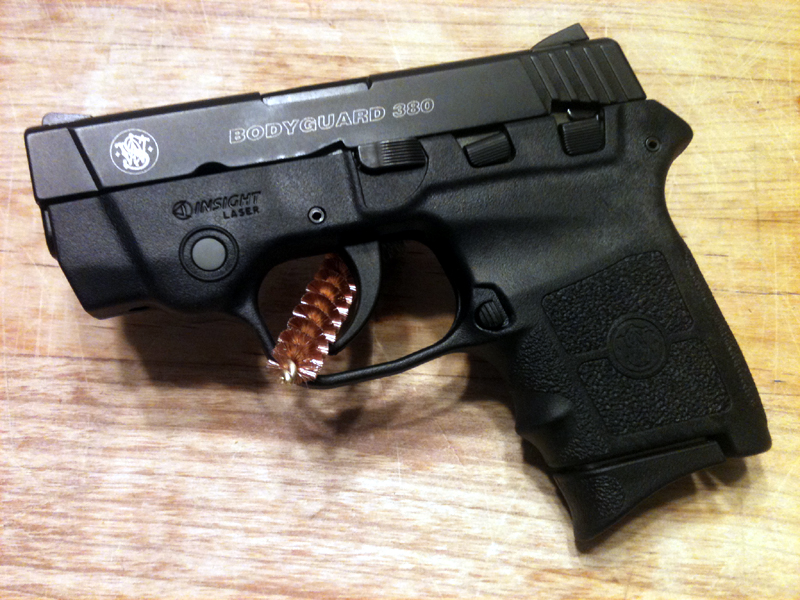 Not content with just one BAG day purchase, I went out and bought another little firearm: A Smith & Wesson Bodyguard .380. I’ve had a P-3AT for a while, and it’s a fine little pocket pistol. It’s reliable and, if not accurate, easy enough to shoot when needed. Though it does tend to wear my hands out at the range when putting more than just a couple of magazines through it.
Not content with just one BAG day purchase, I went out and bought another little firearm: A Smith & Wesson Bodyguard .380. I’ve had a P-3AT for a while, and it’s a fine little pocket pistol. It’s reliable and, if not accurate, easy enough to shoot when needed. Though it does tend to wear my hands out at the range when putting more than just a couple of magazines through it.
The Bodyguard .380 is slightly larger, and slightly more expensive, but it comes with a few more features that the P-3AT lacked. First and foremost (for me anyway) is the addition of a slide lock and a handy takedown lever. Kel-Tec neglected to put either one of these on their little .380, and that tends to make life a bit more difficult. The designers also included a safety, which I found to be redundant given the stiff (but smooth) DAO trigger, and difficult to use as well. The other selling points of the montre replique sub-compact Smith & Wesson are the inclusion of full-size sights and a top-quality Insight laser aiming device.
.380 pocket pistols are not known for their accuracy, and many have only the most rudimentary of sights atop the slide. The Bodyguard uses a black-on-black Partridge-style serrated front post and rear notch configuration favored by many pistol experts, and this is fine by itself. The addition of the Insight laser just in front of the trigger guard truly sets this pistol at a level above all the others.
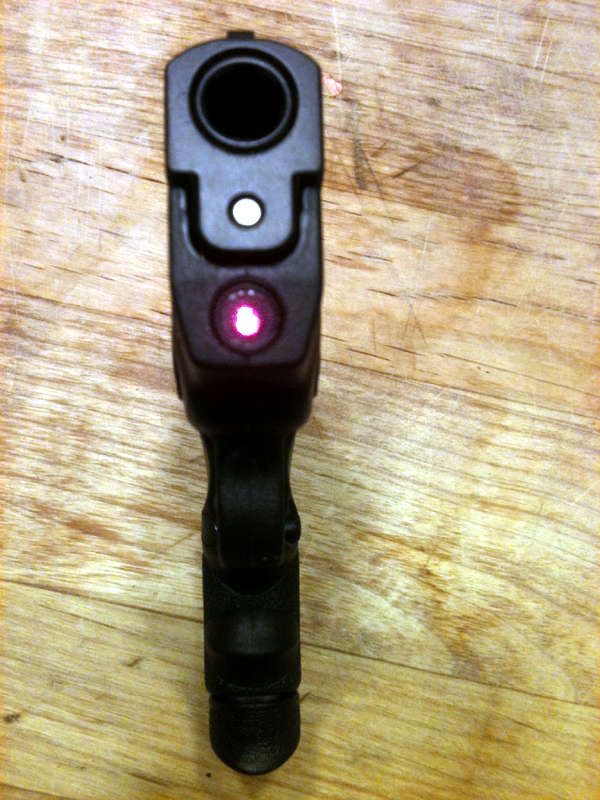
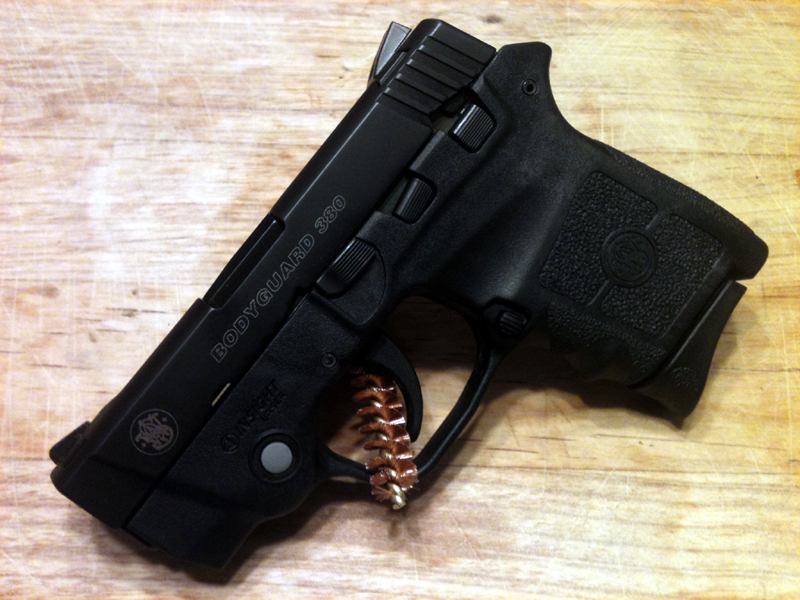
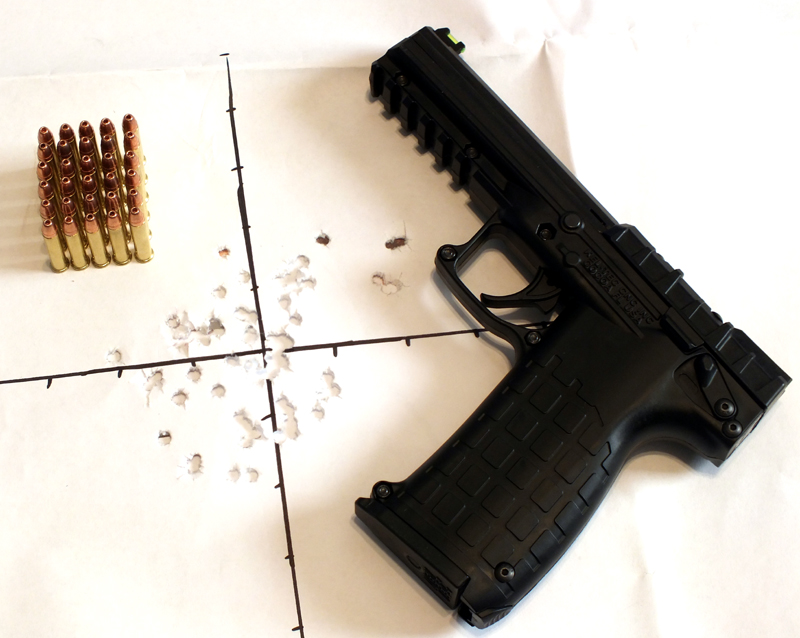 A few months ago I managed to find a PMR-30 in the wild and quickly snatched it up. I’d been lusting after this lightweight .22 WMR pistol for some time, so when the opportunity arose to get one of my own I jumped at the chance.
A few months ago I managed to find a PMR-30 in the wild and quickly snatched it up. I’d been lusting after this lightweight .22 WMR pistol for some time, so when the opportunity arose to get one of my own I jumped at the chance.
After getting the pistol home, I hosed it down with Gun Scrubber to clean out any shipping grease and then lubricated it with Mobil 1 (10W-30) motor oil*. After the first range trip, I determined that it did need the new upgraded 1:11 twist barrel offered as a free Warranty Replacement by Kel-Tec. I emailed them and within a few weeks had the new barrel. It was a simple drop in replacement and I was back up and running.
Since then the PMR-30 has had just over 1,000 rounds through it without being cleaned at all. Until the Central Oklahoma Gunblogger Schutenfest it had not had a single malfunction. At the Schutenfest I and the other bloggers (who all wanted to try it out – and why not? It’s a heck of a lot of fun to shoot) ran about another 500 rounds through it. One malfunction occurred around round 550 when we had a round-nose bullet catch on the feed ramp: not a horribly unusual problem, and not one I felt I could blame on the gun.
Another malfunction occurred at round 653 when I had a Failure to Fire from a dud rimfire round. Inspection of the round showed a good primer strike. The cartridge simply failed to fire. This type of problem is endemic to breitling kopia rimfire rounds of all types, and is not one that could be blamed on the pistol.
Other than those small issues, George Kellgren’s unique design ran like a champ with nary a hiccup, a testament to the engineers who overcame the many unique problems presented by the .22 Magnum in a semiautomatic pistol design. Between the long cartridge design, late peak pressure of the .22WMR, and unique problems presented by the “coffin” style 30-round magazine, the PMR-30 truly is a feat of modern design.
Now I just need to go bug Dennis about getting one of his custom PMR-30 holsters.
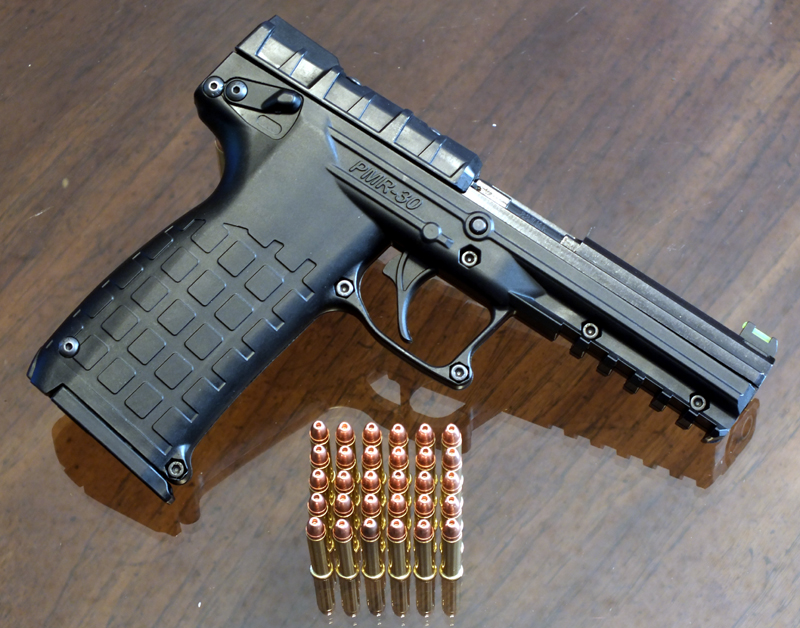 MSRP: $415
MSRP: $415
Caliber: .22WMR (.22 Magnum)
Rounds Fired: 1012
Failures: 1 Failure to Feed, 1 Failure to Fire
Magazine capacity: 30 rounds
Twist: 1:11 Inches
Trigger pull: 3.5 to 5 lbs
Weight (no mag): 13.6 oz.
Muzzle Velocity (40 gr): 1230 fps
Barrel length 4.3 Inches
Length: 7.9 Inches
Height: 5.8 Inches
Grip Width: 1.1 Inches
Max width, across safety levers: 1.3 Inches
*Why Mobil 1 motor oil? Because it’s a heck of a lot cheaper than any other “gun lubricant” and actually performs better. Many gun lubricants will begin to burn off as a firearm heats up during rapid fire, and the magnum .22 cartridge generates a lot of heat, especially when burning through a full 30-round magazine. Mobil 1 synthetic motor oil does not burn off nearly as quick and in my experience provides much more reliability across all firearm platforms.
Training is an important part of everyone’s life. No matter what you do in life, you train for it. Some people train at sitting on the couch and watching TV. That isn’t quite as useful as someone who trains at surfing the internet (I’m pretty sure I’m well on my way to becoming a pro at that) but the really useful training is what I want to talk about.
Directed training. Training with a plan. Training that you continue to practice and hone on a regular basis in a controlled environment.
When it comes to preparedness, there are any number of skills that can be improved dramatically with just a bit of training, and lost fairly quickly if that training is discontinued. Defensive pistol shooting is one of those skills.
Most preparedness-minded individuals agree that personal and family protection in the form of a firearm is a very important part of being prepared, right up there with food and first-aid. Far too many people however simply purchase a pistol and a few boxes of ammunition and call it done.
Even if you have the right equipment it is useless if you cannot reliably and successfully employ it when needed. An unplanned trip to the range to shoot off 150 rounds slow-fire at a bulls-eye target helps. A little. A very little.
The primary problem is that the majority of ranges do not allow shooters to practice draws from concealment or transitions from target to target. There are many reasons for this: safety and insurance restrictions to name but a few. Most ranges have a hard enough time keeping people from shooting the paper-hangers.
How do you get started? Where can you go to learn and practice defensive pistol techniques? The first step should be research and find a knowledgeable teacher and to enroll in a defensive pistol course. There are literally hundreds of places with quality instructors where you can get started. But once you’ve spent a weekend learning the basics, where can you go to practice?
If you do not have a range near you with open bays that allow moving and shooting and drawing from concealment, one of the best ways I’ve found to get at least a little bit of practice is to join IDPA. The International Defensive Pistol Association is an action-pistol league run by Bill and Joyce Wilson of Wilson Combat fame, and is based out of Berryville Arkansas. The league was started by Bill Wilson, Ken Hackathorn, and Larry Vickers as an alternative to IPSC and USPSA, which had turned into “gun races” with highly specialized speed-draw holsters, highly-tuned race guns, and custom ammunition. The purpose of IDPA is to provide a environment where competitors can hone their defensive pistol skills utilizing “stock” equipment that would be suitable for concealed carry.
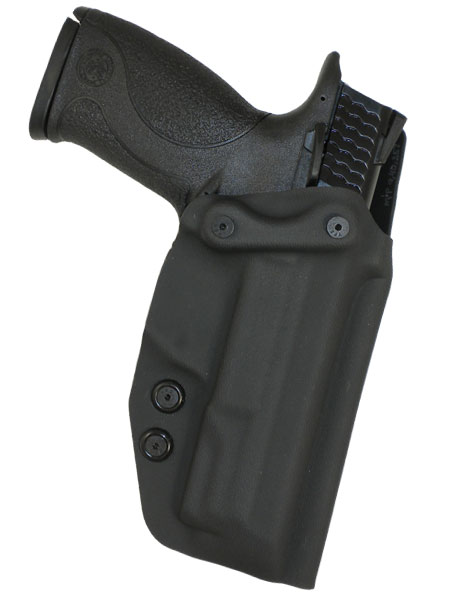 A quality holster like this one from Comp-Tac is perfect for both IDPA and daily concealed carry. |
While IDPA competition and training does much good in enhancing valuable skills and further ingraining the muscle memory necessary for a rapid draw and presentation, it is not without some drawbacks. The primary problem many people have experienced when attending their first few matches begins with the discovery that the firearm and holster they have already purchased do not conform to the guidelines set forth in the IDPA rule book.
With few exceptions, to compete in IDPA you need a plastic or Kydex IWB strong-side holster, or an OWB holster that fits your belt like a glove, and that can be reholsterd easily. This eliminates most leather IWB holsters as being suitable for use. Other holsters that require the muzzle to be swept around for proper presentation such as a shoulder holster, crossdraw, or small of the back holster are are all illegal (and may actually be unsafe) for competition.
Many popular defensive pistols are disqualified, or must be handicapped, right out of the box. My Para Ordnance 14.45 (legal for use in ESP or CDP) for example is not allowed to be loaded to full capacity in any IDPA competition. Common modifications such as sights or pinned grip safeties are also illegal. In fact, I’m pretty sure even modifying a Series 80 1911 by removing the firing pin block in order to get a smoother trigger is illegal in CDP.
In addition, with the exception of the occasional back-up gun or “BUG” match, subcompact and smaller firearms that are the most popular for concealed carry are, where legal, uncompetitive, if not outright banned from regular competition for failure to make power factor or other reasons.
We understand that at the end of the day, IDPA is just another “gun game” with the rules necessary to level the playing field for competitors. But for those seeking just a chance to run their defensive pistol setup under the stress of the timer, and with so many rules complicating things and forcing competitors to act in ways they would never act in a true self-defense situation, is it really worth all the trouble?
We spoke with IDPA 5-gun master and spokesman Caleb Gidddings of Gun Nuts Media to get his take on the situation, and to understand further what IDPA has to offer.
The bottom line in any self defense situation where you need to actually fire your gun is to get rounds on target as quickly and as accurately as possible. On top of that, you need to be able to judge in a split second whether accuracy or speed is going to be the more critical component in that situation. Shooting IDPA helps prepare you for that eventually as the critical components of shooting such as sight alignment and trigger control are reinforced under simulated stress. IDPA isn’t teaching you tactics, but it is teaching you to be a better shooter. To my knowledge, no one who has ever survived a gunfight has wished at the end of it that they were less competent with a handgun.
Plinking mediocre groups with your Bersa .380 or Hi-Point won’t really make you a better shooter. Competing will.
Caleb makes some good points. At the end of the day, the skills you pick up learning rapid magazine changes, target transition, quick draws and accurate presentations are all things that you will be able to use with few changes from setup to setup. Whether you’re shooting a Glock or a 1911, carrying a Kel-Tec P3AT or a full size FNP-45 Tactical handgun, the basic skills all still apply.
There’s an old saying, “Beware the man with only one gun; he probably knows how to use it.” Yes, it’s true that minor changes in holster, the location (or lack) of a safety, and the size of the pistol will all affect the speed and accuracy of your shooting. But if you have the basics down, you’ll be well ahead of 99% of all gun owners out there.
Don’t be afraid to change up your carry rig. If you carry concealed from day-to-day one way, and shoot IDPA another, you’ll still be just fine should you ever need to deploy your firearm.
Like all organized shooting competitions, IDPA is just another “gun game”, but it’s one specifically oriented towards concealed carry, and one where you can learn a lot and hone the skills you learn in basic defensive pistol courses in a safe and controlled environment. You can find an IDPA league near you on their website at IDPA.com.
I’m not one of the “cool” gun bloggers who got a prototype or advance copy for review. I still have to hunt down most of my own products to review.
No matter.
After more than a year of searching, begging, pleading, and generally making an ass of myself, I finally found a PMR-30. While still significantly over MSRP, it was the first I’d found under $500, and I happened to find it completely by accident while wandering into a gun store more than 1,300 miles from home. Which meant, thanks to our curious gun laws, that I couldn’t take delivery of it there, and instead had to pay extra to have it shipped to another FFL located here in Texas.
There, it would wait for me until I returned home, nearly 2 months later.
I picked it up from my local FFL, and took it straight home for a photo shoot. Oleg Volk I am not, but I did my best to get some decent shots for this article. And I figured out how to get that nifty square of 30 CCI Maxi-Mags alongside the pistol (hint: just dump the container upside-down very quickly and then carefully pull it off).
After the initial photos, it was time to head for the range.
Now, the PMR-30 has been the subject of some controversy. Rimfire cartridges in general are less reliable than their centerfire counterparts. In addition to that, the .22 WMR presents some unique challenges to engineers who would chamber an autoloading pistol in this caliber. It has significantly higher pressure than a .22 LR cartridge, and the late peak pressure can cause case extraction problems.
Kel-Tec uses what they call a “hybrid” blowback design, described by in-house engineer Toby Obermeit as a “hybrid blow-back/locked breach [sic] system … accomplished using what is effectively a floating barrel.”
The PMR-30 has experienced a number of problems, many of which Kel-Tec has blamed on sub-par ammunition. A note was placed in the pistol case, alongside the owner’s manual, discouraging the use of any foreign-manufactured ammunition. Press releases from Kel-Tec have also explored the problems that some have experienced with the pistol keyholing 40 grain CCI Maxi-Mag ammunition.
We decided to approach this issue head-on.
 With a couple hundred rounds of 40 grain hollowpoint CCI Maxi-Mags, we went to the range with the PMR-30. To test the gun, we headed out with the pistol as it comes from the factory with no additional cleaning, lubrication, nor even a break-in period. After more than 200 rounds fired rapidly out of the 30 round magazines, we experienced zero malfunctions, no misfeeds, FTEs, FTFs, and certainly no keyholing as you can see by the image to the left.
With a couple hundred rounds of 40 grain hollowpoint CCI Maxi-Mags, we went to the range with the PMR-30. To test the gun, we headed out with the pistol as it comes from the factory with no additional cleaning, lubrication, nor even a break-in period. After more than 200 rounds fired rapidly out of the 30 round magazines, we experienced zero malfunctions, no misfeeds, FTEs, FTFs, and certainly no keyholing as you can see by the image to the left.
No, the little gun performed admirably with nary a hiccup, and with a reasonably tight group fired rapidly at 10 yards off-hand. Despite the fact that our gun did not have the “updated” barrel, and using ammunition reputed to have serious keyholing problems, we experienced no issues whatsoever.
What can one conclude from this?
In our opinion, not much. This is a great trail and hunting pistol for areas where bears are not common, and we intend to test it as such. Accuracy seems to be adequate, but we’ve not yet seen how well it performs on small game.
We’ll continue to shoot it, test it, and even compare it to other similar fireams such as the AMT AutoMag II and the FN Five-seveN (centerfire though it may be). In addition, we’ll be requesting a replacement barrel from Kel-Tec with the upgraded twist rate, and report back on the differences.
Hunting season is upon us, but I’m not sure how much and to what extent I’ll be able to participate this year. Work has me out and away from my normal hunting grounds, so unless I can get out later in the season, it looks like my freezer may be a bit short of venison this year.
Still, feral hogs are always in season in Texas, and while they’re one of my favorite prey, it’s hard to beat a nice venison backstrap. One of my frustrations with hunting is the difficulty that non-resident hunters have in obtaining licenses in various states. Texas is one of the more friendly non-resident hunting states, while others such as North Dakota (where I am currently) require lottery registration for tags far in advance of the actual hunting season, which makes it difficult for someone with an unpredictable schedule to take the opportunity to hunt when it presents itself.
But enough of my whining.
In a few days I’ll be picking up my new shoulder rig from TheHolsterSite.com for my .44 Magnum Ruger Redhawk as part of my new handgun hunting project. The idea is to have a setup that is light, easily portable (no snagging a slung rifle on trees or shrubs), and still capable of taking large and medium sized game.
If you haven’t had the chance to see the holsters that Michael makes, go check out his site. I’ll wait.
I’ll be posting pictures and a review of the new rig here in the coming days and weeks, and if I have time to venture out into the woods this season, I’ll hopefully have a few hogs or deer to show as well.
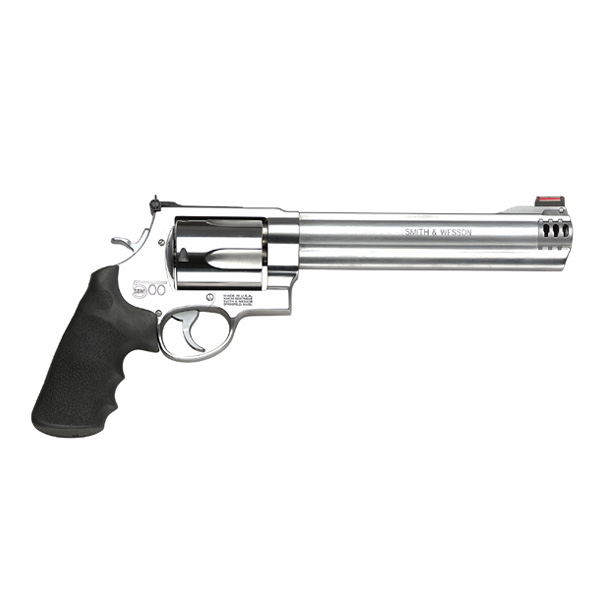 |
I was pleasantly surprised to see the massive S&W .500 Magnum revolver make an appearance as the first firearm challenge on the Season 3 debut of Top Shot on the History channel. Big caliber aficionados and recoil hounds like myself have long had a soft spot in our hearts for any model firearm that can claim to be “the most powerful production revolver in the world,” even if it’s no longer Dirty Harry’s iconic .44 Magnum.
Contestants on Top Shot last night faced off in what would turn out to be the team selection challenge with three targets to be hit with a massive S&W 500 slinging bullets weighing somewhere between 300 and 500 grains at more than 1,500 feet per second out of an 8.38 inch barrel. Colby tossed out the comment that this revolver is capable of taking any animal that walks this earth… a claim that echoes Smith & Wesson’s own advertising copy, and although I’m not sure I’d try it out on large or dangerous African game, it is certainly capable of taking any North American game animal. That, after all, is what most readers of this blog are concerned with (but if you happen to be on safari in Africa with this handgun and want to give it a go, be sure to email us and let us know how that worked out for you).
Belching a massive 350 grain projectile at almost 2000 feet per second, the S&W 500 generates a stunning 3,050 lb-ft of energy at the muzzle. By comparison, a 180 grain .308 caliber bullet fired at 2,600 feet per second has a muzzle velocity of only 2,800 lb-ft. At distances under 200 yards, the .500 is more than capable of taking deer, elk, moose, or even bear with a properly placed solid hard-cast bullet.
From the factory, the 500 comes equipped with a rear adjustable sight and fiber-optic front sight, which makes aiming easier in the low light conditions around sunrise and sunset when game animals are most active. It holds 5 rounds, which is (or should be) plenty for most hunters, but as we saw on Top Shot last night, it’s still possible to need to top off the gun. With 3 targets at increasing distances, a 50% or greater miss rate required a number of the shooters to reload.
The difficulty here isn’t that the gun is inaccurate or that the targets on the show were necessarily difficult to hit. Quite the contrary, this revolver is extremely accurate and able to reliably hit targets out past 400 yards. The problem is that it takes an unusual amount of strength and control to keep the 8″ barrel of the massive X-frame gun on target. At over 4.5 pounds unloaded, this revolver is no lightweight handgun. Fully loaded and topped off with a scope, it can easily tip the scales at more than 5 pounds. Add in the fact that most of that weight is hanging far out from the fulcrum of the shooter’s grip and it’s easy to see why the shots are difficult to keep on target when shooting off-hand. That being the case, ethical hunters and outdoorsmen would do well to use shooting sticks, stands, or trees to stabilize this big hand-cannon, or shoot from more stable positions such as sitting, kneeling, or prone.
Despite the large caliber of the Smith & Wesson .500, it’s not particularly difficult to shoot. Recoil, while significant, is easily managed. The soft hand-filling grips and an effective muzzle-brake combined with the weight of the frame and barrel make it, if not comfortable, at the very least not punishing when the big half-inch magnum load is touched off.
Still, it’s big, heavy, and LOUD. Inevitably, when shooting a handgun such as this at the range, somebody will come up and politely ask to see what it is you’re shooting.
Unless you’re at an indoor range. Then they will usually shout, “HEY! You wanna give us fair warning before setting that gorram hand cannon off in here?!”
Which is often followed up with “What the heck do you use that thing for anyway?”
The only answer to which is “Dragons.”
“Dragons? Are you crazy? There aren’t any dragons around here!”
But of course. They’re smart, those dragons. That’s why they haven’t been seen in North America for a while. They heard I had a .500 Magnum and took off for lands where the virgins are more plentiful and the most powerful production revolver in the world hasn’t been invented yet.
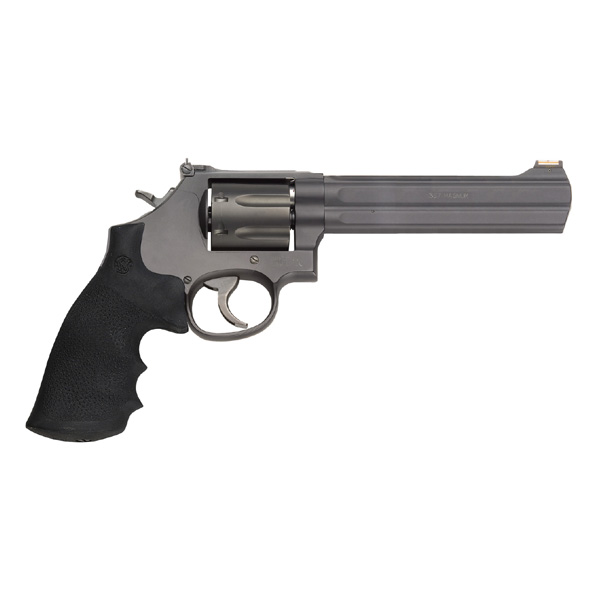 I got started hunting medium game such as deer and hogs with a traditional hunting rifle. For most hunters, deer season consists of dusting off the .270, confirming zero at the range, and then setting up a blind or tree stand in a place where deer are likely to be.
I got started hunting medium game such as deer and hogs with a traditional hunting rifle. For most hunters, deer season consists of dusting off the .270, confirming zero at the range, and then setting up a blind or tree stand in a place where deer are likely to be.
For some, this is all they want out of hunting season: some quality time spent out in the woods and the chance at bringing home some venison. For others, like myself, this is not enough. It’s not difficult to set up in a good location on properly scouted land and be able to tag a deer at 100 yards or more with a modern hunting rifle. For hunters like myself the desire to hone skills and become more intimate with the prey drives us to use more primitive methods.
Many hunters move over to bow hunting. Modern compound bows however are nothing like their ancient counterparts, and it’s not truly fair to refer to them as “primitive.” But successfully employing one in a hunt requires quite a bit of skill nevertheless. They require a hunter to set up a blind much closer, or in some situations require them to learn to quietly stalk to within 30 yards or less in order to set up a good shot.
Arguably not as difficult to utilize as a modern compound bow, handguns bridge the gap between rifle and bow hunting. They don’t pack the power of a rifle, and the shorter trajectory and lower energy of these platforms makes their effective range limited. Still, the familiarity of the trigger and aiming system makes their use somewhat familiar to hunters.
Most important, for myself at least, is the fact that getting started hunting with handguns doesn’t require a massive investment if one already has a rifle hunting setup. Bow hunting requires purchasing not just an adequate bow, but also arrows, quiver, broadheads, a trigger/release, and aiming system. This expense can quickly run into the thousands of dollars.
On the other hand, a quality .357 or .44 magnum revolver can be acquired for less than $500 used. Many hunters already have lever action rifles chambered for these calibers, but even a hunter with only a .308, .270, or .30-06 bolt action rifle can find single shot pistols chambered in the same calibers they already own. Thompson Center Encore pistols for example can be found chambered in the relatively easy shooting .243, .270, 7mm-08 and .25-06 calibers and are often scoped to make shooting out past 100 yards a simple matter.
Check your local hunting regulations before investing in a handgun for hunting. Not all jurisdictions allow the use of handguns, and some of those that do have minimum requirements with regards to caliber and muzzle energy. If a bit more challenge is what you’re seeking this hunting season, keep an eye out for some upcoming articles on the type of hunting handguns suitable for bringing Bambi to the table.
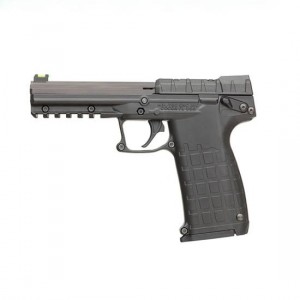 Kel-Tec claims they’ve shipped their newest gun, the PMR-30. I’ve been eagerly awaiting my own since ordering it back in April. I’ve been checking regularly with my local gun dealer – so far my pistol hasn’t come in yet.
Kel-Tec claims they’ve shipped their newest gun, the PMR-30. I’ve been eagerly awaiting my own since ordering it back in April. I’ve been checking regularly with my local gun dealer – so far my pistol hasn’t come in yet.
I’ve long had a passion for .22 WMR autoloading pistols. Many people will argue that, if you want a .22 magnum pistol, you’re better off picking up an inexpensive and reliable revolver. Rimfire revolvers have been around for well over 100 years, and the technology is well refined. But there’s something to be said about having 10, 20, or even 30 round at your disposal without the need to reload.
A number of years ago I picked up an old AMT Automag II in fair condition. Long and lean, it looked like a cross between a 1911 and a Beretta 92 that had been crafted from shiny stainless steel. One of the first magnum autoloaders ever developed, it had a number of problems. Extraction issues caused by the late peak pressure of the .22 magnum load were ingeniously solved by engineers who had a number of tiny ports drilled at 90 degree angles into the chamber.
Later I came across an old Grendel P-30 in fair condition. It was an interesting pistol, but prone to feeding problems. Fun to shoot (when it would cycle), it looked like something out of Blade Runner. Unlike the AMT Automag II, I was never able to get my Grendel to cycle properly, despite the amount of money I gave my gunsmith.
Imagine then my excitement when FN Herstal came out with their Five seveN pistol, appropriately named given the 5.7x28mm cartridge it fired. The Five seveN boasted a 20 round magazine capacity and slightly better ballistic performance than the .22 magnum. It was also supremely reliable, though at a very high price. It wasn’t just the pistol that was expensive, retailing for more than $1,000. Ammunition, initially only available through FN, was priced over $0.50 per round. Of course I bought one anyway and still have it, though I don’t shoot it as often as I’d like to owing to the high cost of keeping it fed.
So when Kel-Tec, under the direction of George Kellgren the original designer of the Grendel P-30, announced that they were developing a .22 magnum autoloader it piqued my interest. So far however, Kel-Tec has been long on promises and short on delivery. Initial promises of an April delivery date soon became May and then June. Finally in July Kel-Tec announced that they had shipped their first delivery of PMR-30s. It’s August now, and no one can seem to find them yet.
I’ve got my ears to the ground and am eagerly looking for my own model, but so far haven’t found any dealers or distributors who have any. As soon as I find one however, you’ll find the review here.
Website hosting provided byKyndar.net
